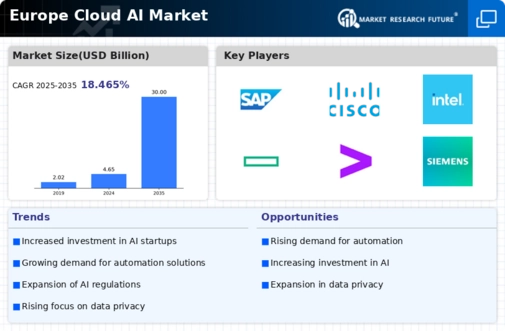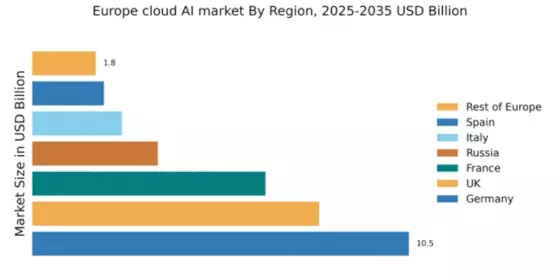Germany : Strong Infrastructure and Innovation Hub
Germany holds a commanding 10.5% market share in the European cloud AI sector, valued at approximately €3.5 billion. Key growth drivers include robust industrial automation, a strong emphasis on data privacy regulations, and government initiatives promoting digital transformation. The demand for AI solutions is surging, particularly in manufacturing and automotive sectors, supported by significant investments in infrastructure and technology development.
UK : Innovation and Investment Drive Market
The UK boasts an 8.0% market share in the cloud AI landscape, translating to around €2.6 billion. Growth is fueled by a vibrant tech ecosystem, significant venture capital investments, and a strong focus on fintech and healthcare applications. The UK government has also introduced favorable policies to encourage AI adoption, enhancing the overall business environment and stimulating demand across various sectors.
France : Government Support and Innovation Focus
France captures a 6.5% share of the cloud AI market, valued at approximately €2.1 billion. The growth is driven by government initiatives like the AI for Humanity strategy, which promotes research and development. Demand is particularly strong in sectors such as retail and transportation, where AI applications are enhancing customer experiences and operational efficiencies. The regulatory framework is supportive, fostering innovation and investment.
Russia : Strategic Investments and Development
With a 3.5% market share, Russia's cloud AI sector is valued at around €1.1 billion. Key growth drivers include strategic investments in technology and a focus on national security applications. The demand for AI solutions is increasing in sectors like defense and energy, supported by government initiatives aimed at boosting local tech capabilities. However, regulatory challenges remain a concern for foreign investments.
Italy : Cultural Heritage Meets Technology
Italy holds a 2.5% share of the cloud AI market, valued at approximately €800 million. Growth is driven by the integration of AI in sectors such as tourism and manufacturing, where enhancing customer engagement and operational efficiency is crucial. The Italian government is promoting digital transformation through various initiatives, although infrastructure development remains a challenge in some regions.
Spain : Focus on Innovation and Growth
Spain's cloud AI market accounts for 2.0%, valued at around €650 million. The growth is supported by a burgeoning startup ecosystem and government initiatives aimed at fostering innovation. Demand is particularly strong in sectors like agriculture and logistics, where AI applications are optimizing processes. However, the competitive landscape is still developing, with several local players emerging.
Rest of Europe : Fragmented Market with Growth Potential
The Rest of Europe holds a 1.77% market share in the cloud AI sector, valued at approximately €600 million. This sub-region includes various countries with unique market dynamics, driven by local demand for AI solutions in sectors like healthcare and finance. Regulatory environments vary significantly, impacting the pace of adoption. Emerging players are beginning to establish a foothold, creating a competitive landscape ripe for growth.


















Leave a Comment